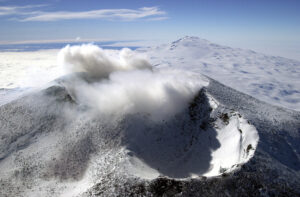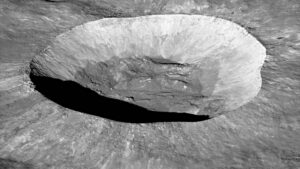Is this the end of the world? It’s a recurring question when we see everything go awry, from political conflicts to crushing recessions. But what about when broad daylight suddenly turns to night? Over the centuries many people have asked this same question when they experienced days, or sometimes months, of persistent dark skies.
New England Dark Day (1780)
George Washington described this day of darkness as a “heavy and uncommon kind of cloud, dark and at the same time a bright and reddish kind of light intermixed with them, brightening and darkening alternately.”
At 10 am, New England and parts of Canada witnessed the sky grow dark, forcing citizens to light candles and fires for illumination. Nocturnal animals started to wake up, and flowers closed their petals for the day. The darkness lasted until midnight.

Dark skies over a plain. Photo: Bernulius/Shutterstock
The odd day took on a red hue which undoubtedly led many to think Judgment Day had arrived. Some pastors in the area deemed it God’s punishment for our sins. However, tree ring and scar analysis from forests in Canada found that a big forest fire took place in 1780. This would have produced a large amount of smoke, blacking out the sun.
Poet John Greenleaf Whittier wrote a poem about the event. He referred to it as the “Twilight of the Gods”.
The Year Without Summer (1816)
In 1816, the world experienced one of the worst climate aberrations ever recorded. It affected Asia, Europe, and North America. The usual warmth of summer was replaced by an average 1°C temperature drop.
At this time, the world was still experiencing the after-effects of the Little Ice Age, which lasted from the 14th to 19th centuries. This caused crop failures and all the physical and social ills that came with it. After the Little Ice Age, a series of volcanic eruptions made matters worse. Eruptions in St Vincent and the Grenadines, the Philippines, Japan, and Indonesia ejected huge volumes of volcanic particles into the atmosphere. This caused the Earth to cool further. So, summer turned into a harsh volcanic winter.

A painting of the still-darkened skies in 1817. Painting: Caspar David Friedrich
Widespread famine, flooding, excessive rainfall, riots, and the Napoleonic Wars made 1816 a terrible time to be alive. But the defining feature of the period was an ever-present dark sky or day fog. Volcanic material remained suspended in the air, unyielding to wind and rain. The air became tinted with a dismal red or brown.
The sunlight was so dim that observers could even see sunspots. Frost from May to August came in brown or red. The sun also happened to be in a dim period, a cycle called the Dalton Minimum, which lasted from 1790 to 1830. This was when the sun had low sunspot activity, causing general cooling.
Artists and writers like J.M.W. Turner, Lord Byron, and Mary Shelley used their experiences and observations of the Year Without Summer as inspiration for some of their famous works.
Black Sunday (1935)
The Great Depression brought about one of America’s worst environmental disasters. Severe drought, poor agricultural practices, and overgrazing by livestock in the Great Plains led to very loose, eroded topsoil. High temperatures and winds created “black blizzards” — powerful dust storms which blackened the sky for hours.

Dust Bowl approaching a home in Texas. Photo: NOAA
On April 14, 1935, the largest dust storm swept across the land with wind speeds of over 96kph. It was 2,896km wide, carried over three tons of dust, and reached over 3,000m high. The dust was so thick that you could not see your own hand. Even cities like New York and Washington DC felt its effects.
Blue Sun and Purple Moon (1950)
While the 1950s saw the economic prosperity of post-World War II, another war was brewing. The Cold War and the threat of a nuclear conflict had everyone on edge. So, when the sun turned blue and the moon purple, people in parts of Canada and the northeastern United States panicked.

The blue sun on a postcard of Toronto in 1950. Photo: Spacing.ca
The day gradually got darker as the sun took on a hazy blue color, hidden behind the towering purplish clouds. At night, the moon turned purple. Animals noticed the sudden change in conditions as well. They either went to sleep, hid, or exhibited other strange behaviors.
The panic became so great that electricity grids and first responders were overwhelmed. Many scrambled for shelter, thinking the Soviets were attacking. However, there is a reasonable explanation.
The Chinchaga wildfire ripped through British Columbia and Alberta, devastating millions of acres. “The Great Smoke Pall” was an inevitable consequence. The wind carried tiny droplets of oil in the air which scattered yellow and red light. This made the moon appear to change color.
Great Smog of London (1952)
Used to dense fogs and colder weather than most countries, the British have traditionally kept calm. However, for one day in 1952, they were unable to carry on. December 5 saw the city of London come to an absolute standstill due to city-wide smog which killed approximately 12,000 people, with another 10,000 taken ill.
Londoners are accustomed to “pea-soupers”, which are yellowish and greenish fogs. However, the Great Smog was much worse. The event resulted from an anticyclone and temperature inversion mixed with various kinds of exhaust. With virtually no wind to carry particles elsewhere and colder than usual temperatures, the particles remained suspended in the air until December 9.

The Great Smog of London in 1952. Photo: N T Stobbs/Wikipedia Commons
That winter, citizens burned more coal than usual. The coal contained high amounts of sulfuric material, leading to sulfur dioxide forming in the air. In addition, the smog contained smoke, hydrochloric acid, and fluorine. Car, bus, and train exhaust, along with industrial plants, contributed too. Public transport came to a halt, and events were canceled. Citizens grew ill with hypoxia, bronchitis, and pneumonia.
On December 9, the smog cleared, but Londoners still dealt with the effects. This disaster forced the government to pass the Clean Air Act four years later, reducing and restricting coal use and establishing smoke-free areas.






